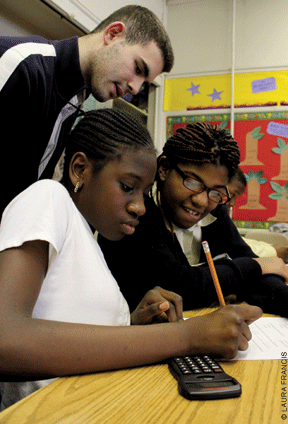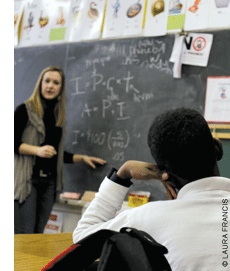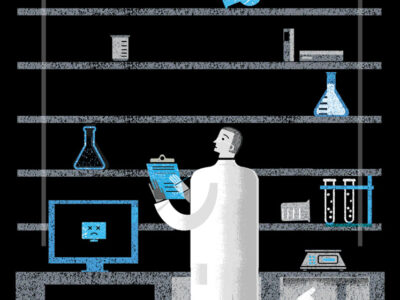
Timothy Chai stepped back from a blackboard smattered with chalk dust and words like bikes, chips, clothes, and Valentine’s cards. He turned, waited a moment, then asked the class, “Alright guys, now what about chicken fingers?”
“It’s a want!” one of the fifth-graders shouted.
“Waaant.”
“Want.”
“NEED!”
The room of students at West Philadelphia’s Lea Elementary School burst into laughter, while Chai, a freshman in both the College and Wharton, launched into a lesson on desires, needs, and their relationship to investments. Chicken fingers may seem an unlikely lead-in for a class on finance, but it fits right into the curriculum of the Financial Literacy Community Project (FLCP), a group founded by Penn undergraduates last fall.

With a fleet of 14 teachers, advising support from Wharton’s management department, and classes designed to spur student participation, FLCP hopes to give West Philadelphia schoolkids the financial savvy to make good decisions—and avoid common pitfalls—as they enter the worlds of cash and credit.
Unlike many of the other tutoring programs at Penn, FLCP’s self-made, self-taught curriculum focuses on questions like “What is money?” and “What are the roles of banks?” According to founding member Mimi Sheng, a dual-degree sophomore in the College and Wharton, FLCP aims to teach the kids the language of banking so they can make sound financial decisions in the future.
“Financial literacy is really a tool you can use for the rest of your life,” she says. “Even after the program, even after we leave, [the students] will still have those tools.”
The program’s goals are timely considering the recent housing market crash and banking crises. More fundamentally, though, FLCP is working to address financial-literacy problems embedded in the West Philadelphia area.
Keith Weigelt, the Marks-Darivoff Family Professor and a faculty advisor for FLCP, points out that West Philadelphia suffers high rates of unemployment and poverty, and that many neighborhood residents rely on “fast cash” outfits for money, taking out payday loans whose exorbitant interest rates—which can amount to nearly 400 percent a year—can easily create a vicious cycle of debt.
A 2009 report from the Federal Deposit Insurance Corporation concluded that at least 17 million Americans are “unbanked” and an additional 21 million are “underbanked.” Low-income Americans are disproportionately likely to lack a bank account—which limits their ability to save and amplifies their susceptibility to payday-loan-style financial services. The problem of unbanked Americans and wealth disparity in general is multifaceted, but FLCP aims to combat it in the classroom.
Says founding member Katherine Long, another dual-degree sophomore: “We’re hoping to address financial inequity” through financial literacy.
Lesson plans—at both Lea Elementary and West Philadelphia High School—explain borrowing, spending, saving, and interest. The high school students, mostly sophomores, also work on college applications, financial aid, and scholarships.
So far, the kids have been enthusiastic about the program.
Sheng says the reaction has been positive. “I was surprised,” she laughs. “We were doing worksheets on compound interest … and [the students] were enjoying it!”
That is not to say the group hasn’t encountered difficulties. Aside from the occasional sigh of “I don’t care,” FLCP has to work past set stereotypes in the community, such as a historical distrust of financial and other institutions. Sheng says that “a few of [the students] feel that banks are out to get you.” Adds Long, “Some attitudes need to be changed. There are just some misconceptions they have. One kid thought that banks rob us.”
For College sophomore Ben Watkins, one of the FLCP teachers, countering those suspicions head-on could be the best part. “FLCP could really make a difference in the decisions in their lives,” he says.
The group is not alone in the initiative against financial illiteracy. It functions under the umbrella of the Wharton-Netter Center-Community Partnership, established last year with an anonymous $3.16 million gift. (The Barbara and Edward Netter Center for Community Partnerships was founded in 1992.)
Sherryl Kuhlman, the managing director of the Wharton Program for Social Impact, says that FLCP is “a small piece of a larger project,” but adds that it could be used as a model for more expansive goals for broader audiences. FLCP plans to put its curriculum online, making it available across the country for free, and in November the group won a grant from DoSomething.org—for a modest $500.That would buy plenty of chicken fingers. But only for someone unschooled in the wonders of compound interest.
—Laura Francis C’13




